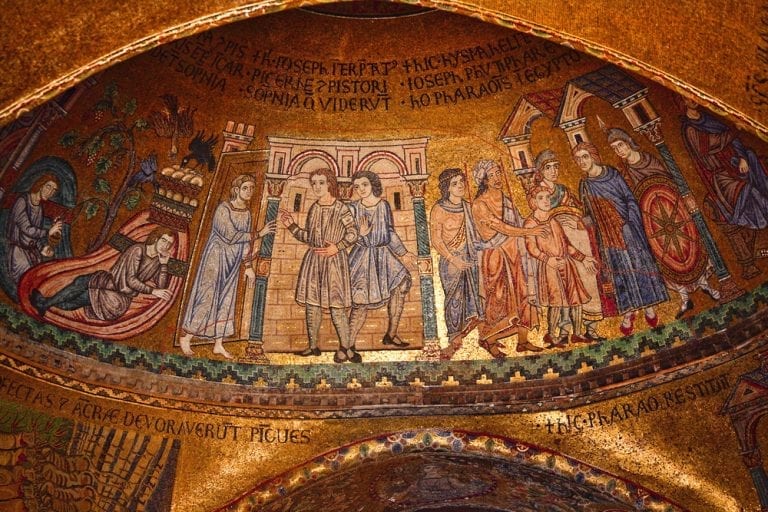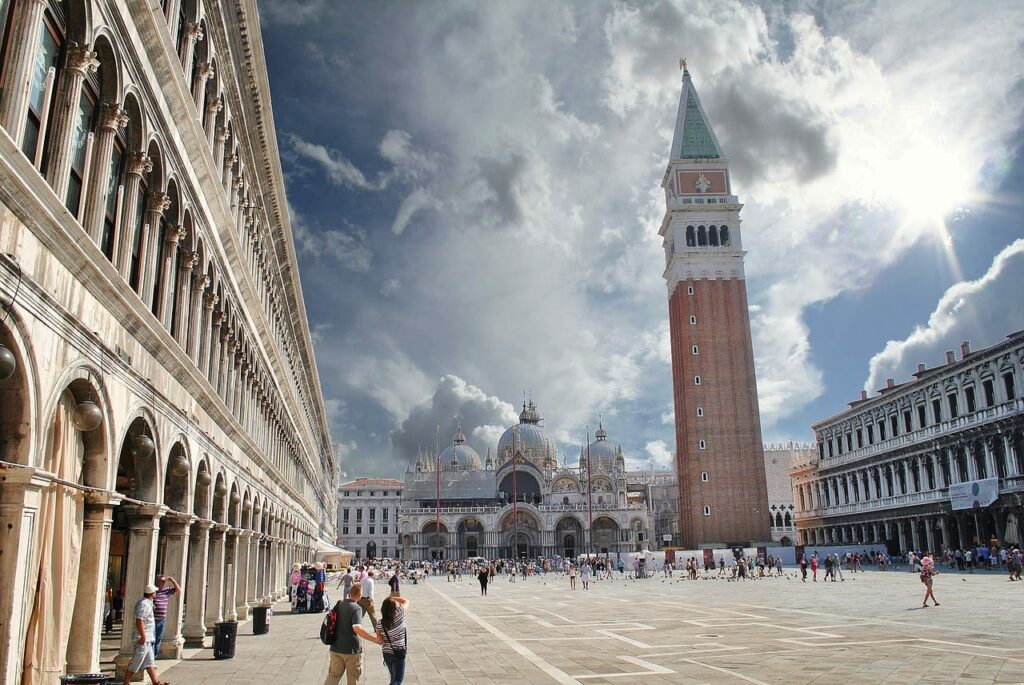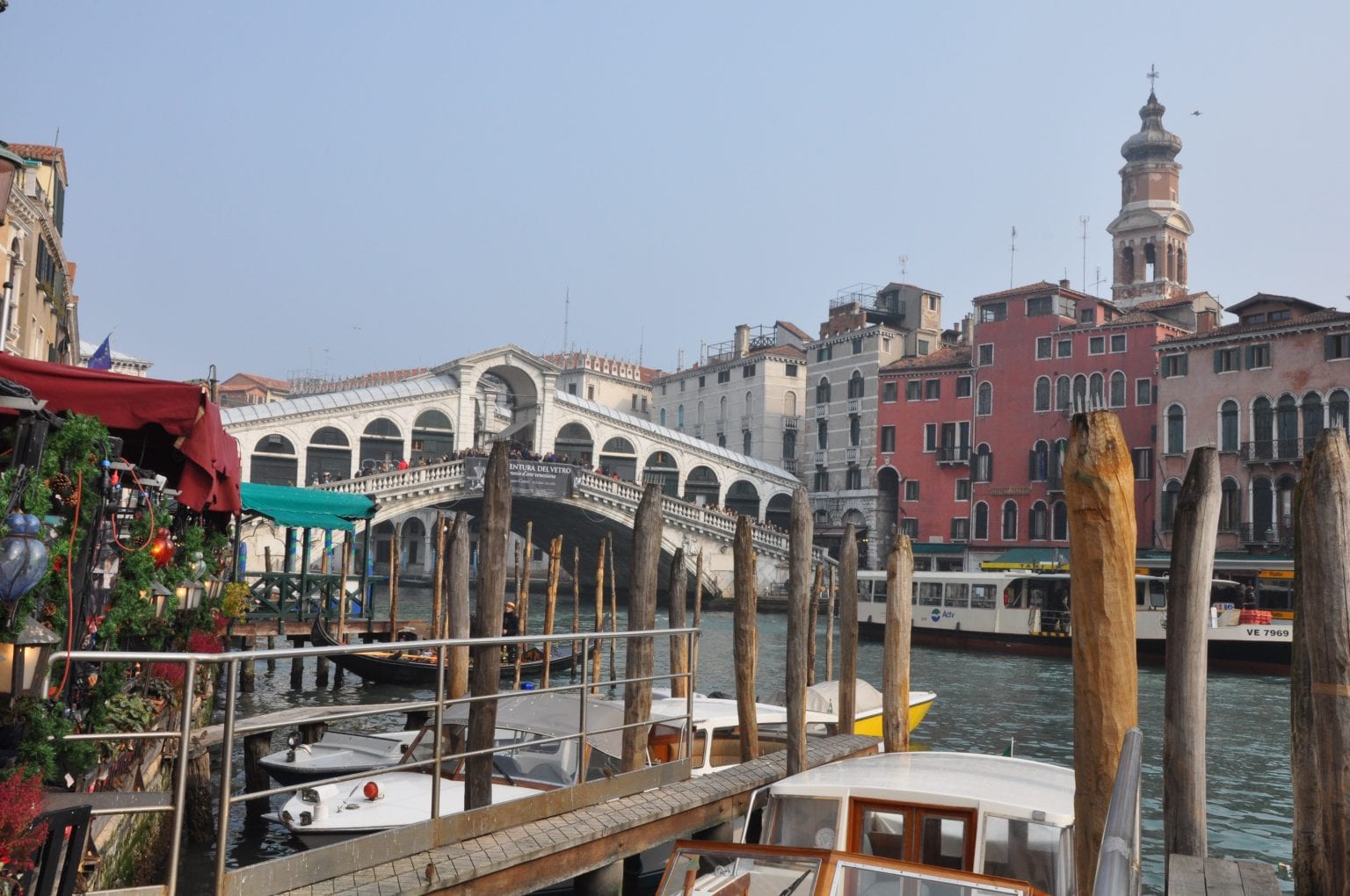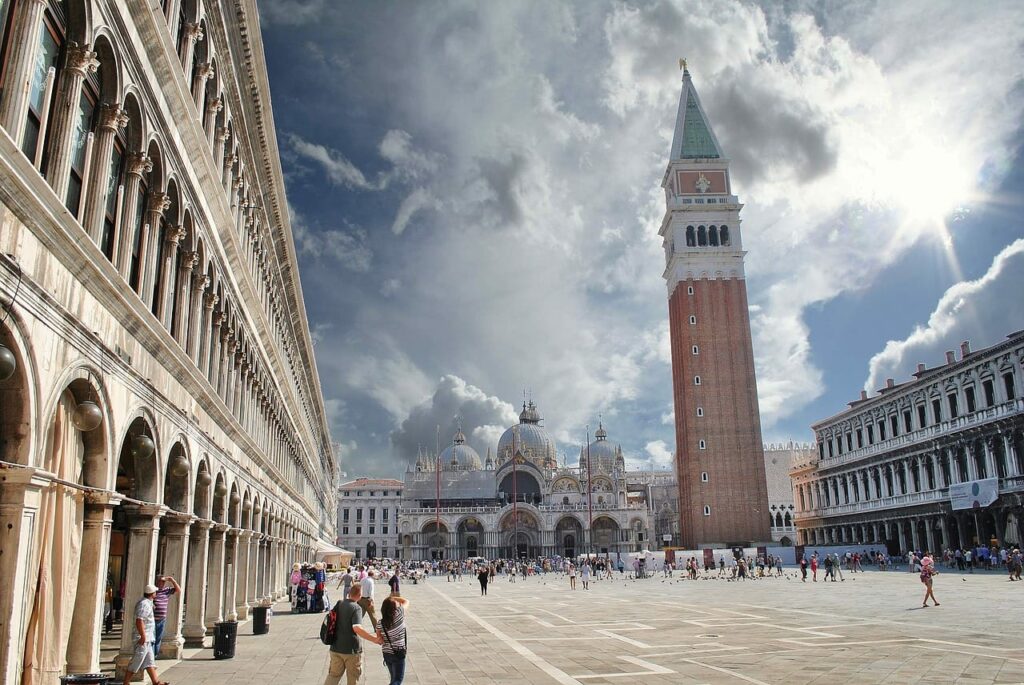खोज करते रहें
वेनिस, इटली
आवश्यक वेनिस
अधिक अन्वेषण करें
सेंट मार्क बेसिलिका वेनिस में सबसे अधिक देखी जाने वाली जगहों में से एक है, और किसी भी यात्री के इटली यात्रा कार्यक्रम पर अवश्य देखना चाहिए! लेकिन एक ऐसे इतिहास के साथ जो 9 वीं शताब्दी ईस्वी तक फैला हुआ है, यह एक चर्च भी है जिसके पीछे बहुत सारी दिलचस्प कहानियां और किंवदंतियां हैं। सेंट मार्क बेसिलिका के बारे में सबसे आकर्षक तथ्यों में से छह यहां दिए गए हैं!
1 बेसिलिका अपहरण की एक धमाकेदार कहानी के साथ शुरू हुई
 सबसे पहले सेंट मार्क बेसिलिका 9 वीं शताब्दी में इस स्थान पर बहुत पवित्र अवशेष-अवशेषों को रखने के लिए बनाया गया था जो चोरी हो गए थे! 828 में, वेनिस के व्यापारियों ने मिस्र के अलेक्जेंड्रिया से चार प्रेरितों में से एक सेंट मार्क द इंजीलवादी के शरीर को चुरा लिया। किंवदंती के अनुसार, वे बैरल में सूअर का मांस की परतों के नीचे छिपाकर (मुस्लिम) गार्डों के पीछे उन्हें छीन लेते हैं!
सबसे पहले सेंट मार्क बेसिलिका 9 वीं शताब्दी में इस स्थान पर बहुत पवित्र अवशेष-अवशेषों को रखने के लिए बनाया गया था जो चोरी हो गए थे! 828 में, वेनिस के व्यापारियों ने मिस्र के अलेक्जेंड्रिया से चार प्रेरितों में से एक सेंट मार्क द इंजीलवादी के शरीर को चुरा लिया। किंवदंती के अनुसार, वे बैरल में सूअर का मांस की परतों के नीचे छिपाकर (मुस्लिम) गार्डों के पीछे उन्हें छीन लेते हैं!
समुद्र में रहते हुए, एक तूफान ने लगभग ग्रेवरबर्स और उनके कीमती कार्गो को डुबो दिया, यह कहा जाता है कि सेंट मार्क खुद कप्तान को दिखाई दिया और उसे पाल को कम करने के लिए कहा। जहाज को बचा लिया गया था, और व्यापारियों ने कहा कि वे चमत्कार के लिए अपनी सुरक्षा के लिए जिम्मेदार थे।
पूरी कहानी 13 वीं शताब्दी के मोज़ेक पर बाएं दरवाजे के ऊपर चित्रित की गई है क्योंकि आप बेसिलिका में प्रवेश करते हैं।
2 1.5 अमेरिकी फुटबॉल मैदानों को कवर करने के लिए पर्याप्त मोज़ेक है!
There are more than 85,000 square feet (or 8,000 square meters) of mosaic in St. Mark’s Basilica… or enough mosaic to cover over 1.5 American football fields! The mosaics were done over 8 centuries, mostly in gold, and the result is astonishing. Enter the basilica at different times of day to see how the light makes the colors and scenes, look different.


3 500 से अधिक कॉलम हैं
सेंट मार्क बेसिलिका में सरासर आकार, और अद्भुत सामान की मात्रा का सिर्फ एक और उदाहरण कॉलम की संख्या है। बेसिलिका में 500 से अधिक कॉलम और राजधानियां हैं, और अधिकांश बीजान्टिन हैं, जो 6 वीं और 11 वीं शताब्दी के बीच डेटिंग करते हैं। कुछ शास्त्रीय, तीसरी शताब्दी की राजधानियों में भी मिश्रित हैं!

4 बेसिलिका के बहुत सारे खजाने धर्मयुद्ध और कॉन्स्टेंटिनोपल से आए थे
चौथे धर्मयुद्ध, विशेष रूप से, सेंट मार्क बेसिलिका को एक विंडफॉल दिया। आखिरकार, यह धर्मयुद्ध था जो 1204 में, कॉन्स्टेंटिनोपल (आधुनिक इस्तांबुल) की विजय के साथ समाप्त हुआ।
The result? A lot of treasure was shipped to Venice, and installed in St. Mark’s Basilica — including the four bronze horses, an icon of the Madonna Nicopeia, enamels of the Golden Altar-piece, relics, crosses, chalices, and patens!

5 पाला डी ओरो क्राउन ज्वेल्स को शर्मिंदा करता है
टॉवर ऑफ लंदन में चमकदार रत्नों को भूल जाओ: शाही परिवार के पास सेंट मार्क बेसिलिका पर कुछ भी नहीं है! पाला डी ओरो, सोने की एक बीजान्टिन वेदी स्क्रीन, सैकड़ों रत्नों से जड़ी हुई है - शाब्दिक रूप से। इनमें 1,300 मोती, 300 पन्ना, 300 नीलम, 400 गार्नेट, 100 नीलम, प्लस माणिक और पुखराज शामिल हैं।
6 वह घंटी मीनार? एक बार ढह गया

सेंट मार्क के 323-फुट (98.6-मीटर) कैंपनील 9 वीं शताब्दी में वापस आ गए हैं। लेकिन इसे 1903 में फिर से बनाया जाना था। कारण? यह ढह गया! यह 16 वीं शताब्दी में फिर से काम किया गया था, और जाहिरा तौर पर अच्छी तरह से नहीं।
यह 14 जुलाई, 1902 को ढह गया। (निष्पक्ष होने के लिए, यह उससे पहले कई भूकंपों से बच गया था! हालांकि इसने बेसिलिका की बालकनी को मलबे में दफन कर दिया, सौभाग्य से, चर्च को ही बचा लिया गया था। लेकिन यह घटना काफी शर्मनाक थी!
1903 से 1912 तक, घंटी टॉवर को ठीक उसी तरह से फिर से बनाया गया था जैसे यह था। बेहतर, सुरक्षित तकनीकों को छोड़कर।
ठीक है हमने छह का उल्लेख किया है, लेकिन चूंकि हम एक रोल पर हैं, इसलिए यहां अधिक आकर्षक अंतर्दृष्टि हैं:
- सेंट मार्क बेसिलिका के अंदर मोज़ाइक के सोने के टुकड़े असली सोने के साथ बनाए जाते हैं!
Venice was in the past a very wealthy city of merchants: what the Republic lacked in military strength or in land domination, it had in riches. The basilica’s mosaics are not just a way to please God and St. Mark or to communicate complex religious concepts, they were also a way to show the wealth of the city to important guests, like kings or ambassadors from other countries.
सुनहरे टुकड़े वास्तव में सोने से बने होते हैं: प्रत्येक में स्पष्ट कांच की दो परतों के बीच एक पतली सोने की पत्ती 'सैंडविच' होती है। कीमती सामग्री के इस तरह के प्रदर्शन के साथ, वेनिस एक ही समय में अपनी भव्य भक्ति दिखा सकते हैं, लेकिन उनके राजनीतिक 'वजन' भी: इतने छोटे देश के लिए एक बेहद महत्वपूर्ण बात।
- बेसिलिका के ऊपर बड़े बाहरी गुंबद वास्तव में नकली हैं!
In Venice, it’s impossible to build huge structures: the terrain is frail, so you have to carefully stick to small, light and flexible buildings. But the Venetians had to find a way to astonish their guests: so they optimized some very clever tricks to cheat the eye and give everyone the impression that the buildings are huge and imposing.
In St. Mark’s Basilica, there is a great example of this: the five big domes that give the building its distinctive shape are just a superstructure made of wood covered with a thin layer of lead. They are actually completely empty: the brick-built domes with the mosaics that you see inside the church are much lower.
We can arguably say that the only role of those big empty domes is to make the building look much bigger than it really is: this way the ships approaching the city could recognize its shape from afar, and be even more astonished by the legendary city rising from the waters.
- 2019 में, एक बड़ा "परिचित अल्टा" पूरी तरह से चर्च में बाढ़ आ गई!
In the Venetian Lagoon, there are tides: sometimes these tides go higher than normal and as a result, some parts of the city get flooded. St. Mark’s Square is the lowest part of the city, so it’s pretty common to see its floor partially or totally submerged in water.
But on November 12, 2019, things went completely out of control: the tide rose so high that it reached the second-highest level ever recorded in the history of the city. The custodians of the church were unprepared for this event: the water not only flooded the antechamber of the basilica, which is at the same level as the square but also the church itself, which is much higher.
The damage was substantial and the building is still recovering: at least this tragic event gave a big push to the completion of the MOSE project, a system of mobile barriers meant to protect the Lagoon from the most dangerous tides. The barriers were tested a couple of times in 2020 and apparently, they worked fine: we all hope they will be able to protect the basilica in the future.
- सेंट मार्क बेसिलिका सबसे पुराना नहीं है, न ही वेनिस में सबसे बड़ा चर्च है!
The St. Mark’s Basilica was built starting from the IX century: but the history of Venice starts way before that moment, in the V-VI century. So there are churches around the city that predate the most important monument: according to historians, the oldest holy building of the city could be the church of San Giacometto, very close to the Rialto bridge. The Rialto area was, in fact, the first spot that was colonized when the islands started to be populated: the city of Venice was actually called “Rialto” for the first centuries.
Despite its enormous size, at least in proportion with the other buildings of the city, St. Mark’s Basilica is also not the biggest church: this title goes to the church of Santi Giovanni e Paolo, home to the very powerful Dominican monastic order. Their monastery was so big that when Napoleon conquered Venice he chose that building to become the first big public hospital in the city: and the hospital is there still today! You can learn more about San Giacometto and Santi Giovanni e Paolo if you take the Welcome to Venice tour or the Venice in a Day tour, which both feature these very important churches!

Special thanks go to our Walks of Italy guide Mosè Viero for sharing these additional interesting facts about St. Mark’s Basilica.
यदि आप अधिक जानना चाहते हैं, तो सेंट मार्क बेसिलिका और डोगे पैलेस दोनों के वेनिस में हमारे अनुभवों की जांच करें- या, वास्तव में वीआईपी यात्रा के लिए, घंटों के बाद सेंट मार्क बेसिलिका तक पहुंचें, जब यह जनता के लिए बंद हो!
खोज करते रहें
वेनिस, इटली
आवश्यक वेनिस
अधिक अन्वेषण करें

